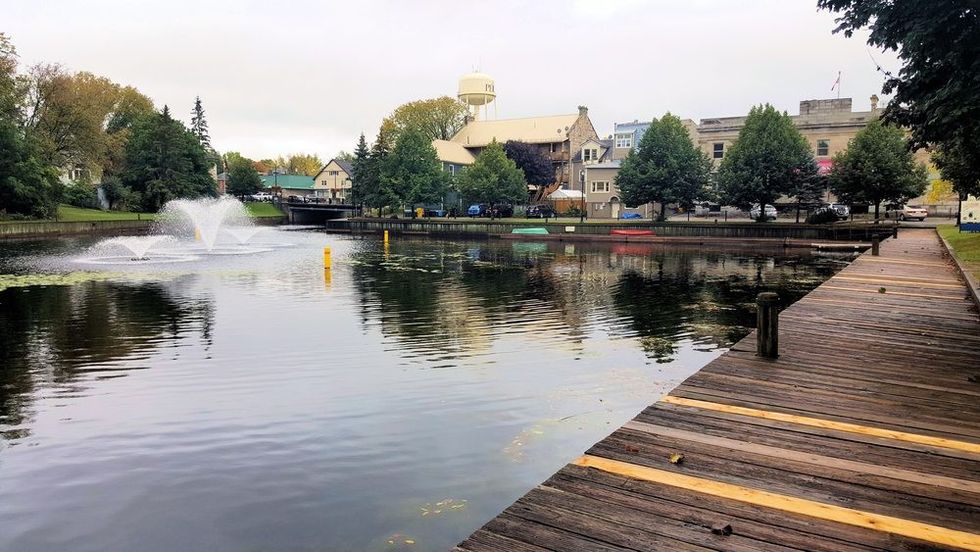The COVID-19 pandemic was the catalyst for an urban exodus that spilled into rural communities and consequently drove up house prices. In Lanark County, a confection of towns and townships fewer than 100 km west of Ottawa, many of those houses were previously long-term rentals, but as buyers from big cities flooded in to purchase them, a lot of those displaced tenants have become homeless.
“I’d say yes, definitely, we’re finding a lot of people are purchasing homes and there are more homeless people now because rentals are unavailable. Rentals are hard to come by, especially over here,” Broker-Owner of Exit Realty Vision Wendy Ronberg told STOREYS. “People leaving cities are purchasing in Carleton Place, Almonte, and Smiths Falls. A lot of people have decided to leave Ottawa and don’t have to do the commute anymore, and they have more land and want to be rural and get detached homes, but a lot of those properties used to be rentals.”
Landlords in these small communities are cashing out by selling properties that, in many cases, have housed the same families for years. Ronberg recounts how a client from Toronto moved out of his downtown shoebox condo and bought a house in Lanark County, which gave the family that had lived there for more than 15 years just 60 days to vacate. Ronberg and the seller’s agent helped the family find another rental, but it wasn’t easy.
RELATED: Prince Edward County’s Growth Leaves Renters Out in the Cold
“We knew they’d have a tough time finding another rental property for that price,” Ronberg said. “I usually try to help tenants if I’m displacing them find another property; both the other agent and myself helped the tenant find another place, but they’re not typically out there. ‘Do you have another $500?’ is what we often hear. The rental accommodations aren’t out there because a lot of the displaced are on fixed incomes, like Ontario Works or ODSP [Ontario Disability Support Program].”
Housing affordability challenges in Canada's major markets grab headlines all the time, but scarcely, if ever, do small town woes receive as much attention. Since the pandemic began and the Bank of Canada plunged interest rates, essentially creating the conditions that have led to rural communities developing houses crises, this story is becoming familiar. In Carleton Place, one of the main towns in Lanark County, house prices are rivalling bigger cities. In fact, there’s an MLS listing for a house at 21 Reynolds Ave. that has a $1.2 million asking price. Kim Angell, Housing Advocate & Children’s Program Worker at Lanark County Interval House and Community Supports, grew up in the county and hardly recognizes it from her high school days.

“I grew up in this town and it’s completely different now. It’s bigger and there’s constantly development. The price of real estate from when I was in high school and now is different,” she said. “Detached homes are $1.5 million in Carleton Place and on the outskirts of town. Even a couple of townhouses are listed that high.”
Lanark County Interval House and Community Supports is a shelter primarily for women and children fleeing domestic violence and abuse, but it works closely with the entire community. Angell noted that the paucity of social housing in Lanark County, where the population is around 69,000, is so acute that there’s an eight-year waiting list.
That means the housing crisis in Lanark County existed before the pandemic created conditions that sparked the urban exodus into rural Canada, however, there’s no doubt COVID-19 exacerbated it, Angell says.
Dissimilar from large cities like Toronto and Montreal, where the homeless sleep atop subway vents or in any crevice they can find, Lanark county’s homeless are sometimes housed in motels on the side of the highway leading into Carleton Place and Smiths Falls. A resident told Angell that their one-bedroom costs $1,300 a month at the motel, which the town subsidizes, although she’s unsure by how much. Others stay with friends and family.
“In urban centres where homelessness is visible, you can’t ignore it, but that’s not the case with rural areas. People look like they’re not homeless because they stay with friends, but they are; or, they camp in a safe place in the forest,” Angell said. “It’s hidden homelessness and I don’t think anyone who works in social services in our community is surprised.”

Lanark County Interval House and Community Supports conducted a rough head count of the homeless -- it counted 58 people, 59% of whom are female -- but Angell stresses that it is difficult to get accurate data.
“In our organization, we reached out to women we knew were experiencing homelessness to get information from them, but not everybody goes to Ontario Works or the food bank,” Angell said of the survey’s shortcomings. “Fifty-eight out of 69,000 doesn’t look like a big number but that’s just the data we could capture. There’s no way for us to get concrete numbers. If you worked at a shelter and people were coming and going, it’d be a lot easier. We’re the only ‘shelter’ in Lanark County but we’re not a homelessness shelter; we’re a domestic violence shelter. Women and families are only supposed to be here for 12 weeks. We had one woman move out who was here for 13 months and she moved into housing we provided.”
Demand for the Lanark County Food Bank’s services has grown substantially during the pandemic, according to its manager Tammy Parent, who fraternizes with a lot of displaced tenants, many of whom are homeless. She says they have become priced out of their own community.
“It’s not only that they can’t afford a place but that there is nothing available because they’re being sold to homeowners who have all that cash from what’s happened with real estate pricing and people being bid out of the process because others are buying homes sight unseen,” Parent said. “That’s leaving some of our folks in the lurch because owners knew they could sell quickly.”
The food bank has watched demand for its services grow even more in the last month because government income programs have officially ended and inflation has caused the price of groceries and petrol to surge.
“It’s hit our clients hard. A regular conversation here is of people coming in who haven’t been here in over a year, as well as of new people coming in, and they complain about the price of gas and groceries,” Parent said.
The wider Lanark community, aware that a growing number of residents are in straits so dire they can’t even afford roofs over their heads, have started donating to Lanark County Food Bank. Ronberg, who understands how pervasive the penury is, is also an active fundraiser for the food bank.

“We are getting a lot of donations,” Parent said. “People thought other people wouldn’t step up because of COVID and the price of gas and groceries increasing, but the community has been unbelievably supportive and we had our best fundraising year.”
While the community has stepped up to the best of its ability, it is far from the panacea needed to end Lanark County’s homelessness crisis, which is rooted in income precarity, Angell says.
If a healthy housing market’s most important fundament is its economy, then local incomes form the substrate. However, in Lanark County, as in much of the country, housing prices aren’t tied to local incomes.
“I’ve had conversations with people trying to hire in Carleton Place. People want to work there but the local businesses can’t pay enough for people to live there,” Angell said. “Income is a huge part of it; it’s not just people who are on social assistance anymore. We’ve known it’s been an issue for people on social assistance for a long time, but it’s starting to affect people who are working and who are just making minimum wage. I don’t make minimum wage and I couldn’t afford to buy a house there.”
A one-bedroom rental averages $1,500 a month in Lanark County but a family home is a minimum of $2,000-2,500. One might even have better luck finding a place to rent in Ottawa for less money than in Lanark County, where a four-bedroom home was recently advertised for $2,700 a month before utilities.
Lanark County Interval House and Community Supports only has four units for transitional housing, and while residents are only supposed to stay there 12 weeks, some have little choice but to stay longer, which the organization permits. Interval House recently purchased a house in Perth that’s being retrofitted into six units.
But COVID-19 has come rearing its ugly head again.
“With the pandemic, it’s been very hard to get work done, but we’re hoping that by mid-January our clients can move in there,” Angell said, adding that the shelter has an additional 15 beds. “The home renovation industry is backlogged because of the supply chain and everybody in the renovation industry is very busy, so it’s outside of our control.”





















